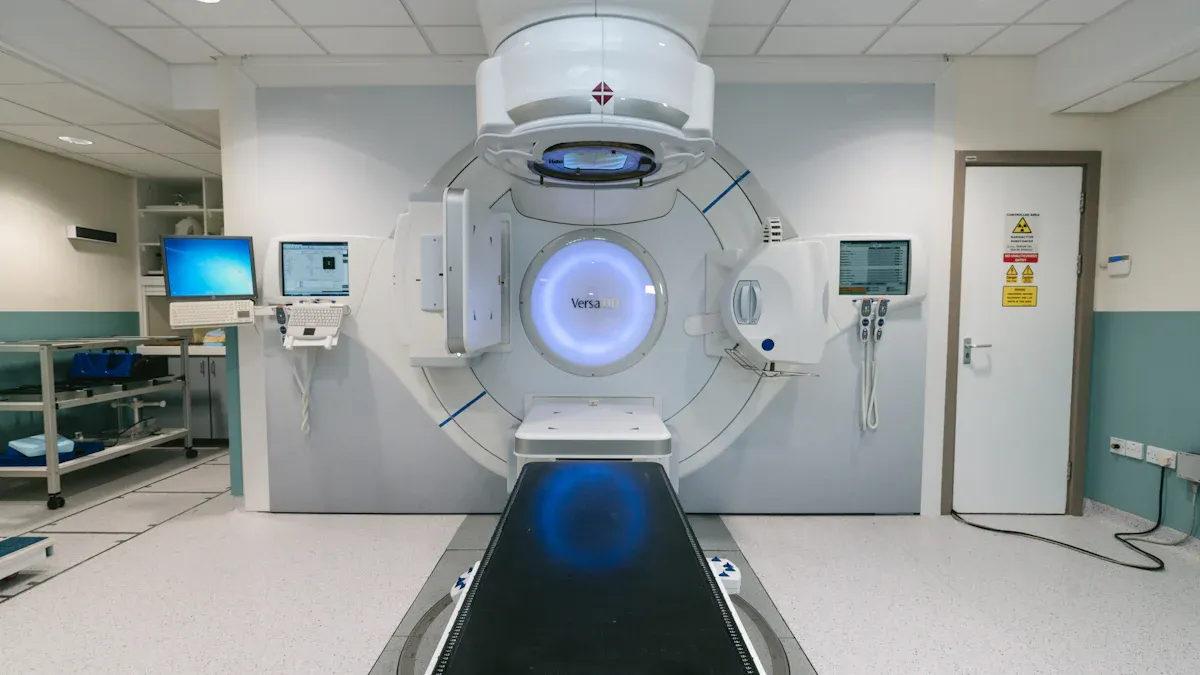Why Overall Resolution Rate Matters in Oncology

The overall resolution rate (ORR) serves as a vital measure in oncology drug development. It evaluates how effectively a treatment reduces or eliminates cancer, providing a clear indicator of its success. ORR combines complete and partial responses, offering a snapshot of how patients respond to therapies. This metric plays a crucial role in clinical trials, helping researchers assess drug performance and predict patient outcomes.
Sobot’s intelligent routing and data analytics solutions can support healthcare organizations in managing ORR data. By streamlining communication and ensuring accurate data collection, Sobot empowers decision-makers to enhance oncology research and improve patient care.
What is Overall Resolution Rate (ORR)?
Definition and Components of ORR
What "response" means in cancer treatment
In cancer treatment, response refers to how a tumor reacts to therapy. It measures whether the tumor shrinks, stops growing, or disappears entirely. This reaction helps doctors evaluate the effectiveness of a treatment. A positive response often indicates that the therapy is working as intended. Researchers use this information to determine the success of drugs in clinical trials. For patients, understanding their response to treatment provides clarity about their progress.
Breakdown of Complete Response (CR) and Partial Response (PR)
Complete response (CR) occurs when a tumor becomes undetectable after treatment. It signifies that the cancer has been entirely eliminated, at least temporarily. Partial response (PR), on the other hand, happens when the tumor shrinks by a significant percentage but does not disappear completely. Both CR and PR contribute to the objective response rate, offering a clear picture of how well a therapy performs.
How ORR is Measured in Trials
Imaging techniques and clinical assessments
To measure the objective response rate in trials, doctors rely on imaging techniques like CT scans and MRIs. These tools provide detailed pictures of the tumor, showing changes in size or shape. Clinical assessments, such as physical exams and lab tests, complement imaging by evaluating other signs of cancer progression. Together, these methods ensure accurate tracking of the tumor's response to treatment.
Standardized criteria like RECIST
Researchers use standardized criteria like RECIST (Response Evaluation Criteria in Solid Tumors) to measure response in clinical trials. RECIST defines specific guidelines for determining whether a tumor has shrunk, grown, or remained stable. This consistency allows for reliable comparisons across different trials, ensuring that the objective response rate is measured uniformly.
Applications of ORR in Oncology
ORR as a benchmark for treatment efficacy
The objective response rate serves as a key benchmark for evaluating treatment efficacy in oncology. It provides a quick and reliable way to assess whether a therapy is effective in reducing tumor size. This metric is especially valuable in early-phase clinical trials, where researchers need to identify promising treatments quickly.
Examples of ORR in clinical trial results
In clinical trials, a high objective response rate often signals a breakthrough in cancer treatment. For instance, a recent study on immunotherapy showed an ORR of 40%, indicating significant tumor reduction in nearly half of the participants. Such results highlight the potential of new therapies to improve patient outcomes.
Why ORR Matters in Oncology Drug Development

Evaluating Drug Efficacy
ORR as an early indicator of treatment success
The overall response rate (ORR) acts as an early signal of how well a drug works in oncology. When a tumor shrinks or disappears, it shows the treatment effect clearly. This makes ORR a reliable endpoint for assessing the effectiveness of new therapies. For example, in immunotherapy trials, a high response rate often indicates that the drug is targeting cancer cells effectively. You can think of ORR as a quick snapshot of a drug’s potential to deliver clinical benefits.
Importance in early-phase clinical trials
In early-phase randomized controlled trials, ORR helps researchers identify promising drugs. These trials focus on testing safety and effectiveness in small groups of patients. A strong response rate can guide decisions about whether to move a drug to larger trials. For instance, if an immunotherapy shows a 50% ORR in Phase I, it signals that the treatment could work for more patients. This early data saves time and resources in drug development.
Role in Regulatory Approvals
How ORR supports FDA and EMA drug approvals
Regulatory agencies like the FDA and EMA use ORR to speed up drug approvals. Their frameworks allow drugs to gain approval based on surrogate endpoints like ORR, especially in oncology. This approach is crucial for rare cancers, where waiting for long-term data could delay access to life-saving treatments. By focusing on response rates, these agencies ensure that patients benefit from effective therapies sooner.
Case studies of drugs approved based on ORR
Several immunotherapy drugs have received regulatory approval due to high ORR in trials. For example, pembrolizumab, an immunotherapy for melanoma, achieved a 40% ORR in early trials. This led to its accelerated approval by the FDA. Such cases highlight how response rates can fast-track access to innovative treatments, improving outcomes for patients.
Relevance to Accelerated Approvals
ORR as a surrogate endpoint for faster approvals
ORR serves as a surrogate endpoint in accelerated approval pathways. It allows researchers to measure treatment effect without waiting for long-term survival data. This is especially important in randomized controlled trials for aggressive cancers. A high response rate often predicts better outcomes, making it a valuable tool for speeding up drug development.
Balancing ORR with long-term outcomes
While ORR provides early insights, it must align with long-term effectiveness. Regulatory agencies require follow-up studies to confirm that the initial response translates into lasting benefits. For example, a drug with a 60% ORR might show improved overall survival in later trials. This balance ensures that patients receive treatments that are both effective and durable.
ORR vs. Other Endpoints in Oncology
ORR vs. Progression-Free Survival (PFS)
Differences in measuring tumor progression vs. response
Progression-free survival measures the time during which a tumor does not grow or spread. It focuses on stability rather than reduction. In contrast, ORR evaluates how much a tumor shrinks or disappears. While ORR highlights immediate treatment effects, progression-free survival provides insights into how long a therapy can control the disease. For example, a clinical trial might show a 50% ORR but a progression-free survival of six months, indicating that while many tumors responded, the effect lasted for a limited time.
When PFS is preferred over ORR
Progression-free survival becomes more relevant when long-term disease control is the goal. You might see this endpoint used in trials for cancers where shrinking the tumor is less critical than preventing its spread. For instance, in advanced ovarian cancer, progression-free survival often serves as the primary endpoint to evaluate treatment success.
ORR vs. Overall Survival (OS)
OS as the gold standard but with limitations
Overall survival measures the time patients live after starting treatment. It is considered the gold standard among clinical trial endpoints. However, it has limitations. Factors like subsequent therapies or patient health can influence survival, making it harder to isolate the effect of a single treatment. For example, a drug might show a high ORR but not significantly improve overall survival due to other treatments patients receive later.
Advantages of ORR in early-stage trials
ORR offers quicker results in early-stage trials. You can assess tumor response within weeks, while overall survival often requires years of follow-up. This makes ORR a practical choice for identifying promising therapies early. For instance, a Phase I trial showing a 40% ORR can signal potential success, guiding further research.
Complementary Role of ORR
How ORR works alongside other endpoints
ORR complements other endpoints like progression-free survival and overall survival by providing immediate insights into treatment effects. While ORR shows how well a tumor responds, progression-free survival and overall survival reveal the therapy's long-term impact. Together, these endpoints create a comprehensive picture of a drug's effectiveness.
Examples of trials using multiple endpoints
Many trials combine ORR with progression-free survival and overall survival to evaluate therapies. For example, a lung cancer trial might report a 45% ORR, a progression-free survival of eight months, and an overall survival of 18 months. This multi-endpoint approach ensures a balanced assessment of both short-term and long-term benefits.
Impact of ORR on Patients and Drug Development

Influence on Treatment Decisions
How ORR guides oncologists in selecting therapies
ORR plays a critical role in helping oncologists choose the best treatment for their patients. By analyzing tumor response data, doctors can determine which therapies are most effective at shrinking or eliminating cancer. For example, if a drug shows a 60% ORR in clinical trials, it indicates that a significant number of patients experienced tumor reduction. This information allows you to make informed decisions about your care, ensuring the selected therapy aligns with your specific needs.
Patient perspectives on treatment response
For patients, understanding tumor response offers clarity and hope. Seeing measurable results, such as a shrinking tumor, can boost confidence in the treatment plan. Many patients feel reassured when they know their therapy is working, even if the cancer isn’t completely gone. This sense of progress often improves emotional well-being and strengthens trust in their healthcare team.
Improving Patient Outcomes
ORR as a predictor of quality of life improvements
A high ORR often predicts better quality of life for patients. When a tumor shrinks, symptoms like pain or difficulty breathing may lessen, allowing you to return to daily activities. For instance, a study on lung cancer treatments found that patients with significant tumor response reported fewer symptoms and improved physical function. This connection between ORR and quality of life highlights its importance in evaluating therapies.
Real-world examples of ORR-driven treatment success
Real-world cases demonstrate how ORR impacts patient outcomes. In one trial, a breast cancer drug achieved a 50% ORR, leading to symptom relief for half of the participants. These results show how effective treatments can transform lives. By focusing on tumor response, researchers and doctors can identify therapies that offer tangible benefits to patients.
Accelerating Drug Development
ORR’s role in identifying promising therapies
ORR helps researchers identify promising treatments early in the drug development process. A high tumor response rate in Phase I or II trials signals that a therapy may succeed in larger studies. For example, a new immunotherapy with a 70% ORR in early trials could move quickly to Phase III, saving valuable time. This efficiency ensures that patients gain access to innovative treatments sooner.
Reducing time to market for life-saving drugs
By using ORR as a key endpoint, drug developers can reduce the time it takes to bring life-saving therapies to market. Regulatory agencies often accept ORR data for accelerated approvals, especially in oncology. This approach benefits patients with aggressive cancers who cannot wait for long-term survival data. Faster approvals mean you can access effective treatments when you need them most.
How Sobot Enhances ORR-Driven Decision-Making
Intelligent Routing for Clinical Trials
Ensuring accurate data collection and analysis
Accurate data collection is essential for measuring the overall resolution rate (ORR) in clinical trials. Sobot’s intelligent routing system ensures that data flows seamlessly between stakeholders, reducing errors and improving accuracy. By integrating human expertise with AI, clinical trials achieve better results. For example, studies show that combining human and AI methods improves chart-level accuracy to 78.7% compared to 76.7% with human-alone methods. Additionally, the median review time drops from 43.9 minutes to 34.1 minutes. This efficiency ensures that trial data remains reliable and actionable, helping you make informed decisions about treatment efficacy.
| Method | Chart-Level Accuracy | Median Review Time (minutes) |
|---|---|---|
| Human-alone | 76.7% | 43.9 |
| Human+AI | 78.7% | 34.1 |
| AI-alone | 63.5% | N/A |
Streamlining communication between trial stakeholders
Sobot’s solutions simplify communication across clinical trial teams. With features like automated workflows and centralized data management, you can ensure that every stakeholder stays informed. This streamlined approach minimizes delays and ensures that critical information, such as ORR data, reaches the right people at the right time. By improving collaboration, Sobot helps you focus on advancing oncology research.
AI-Powered Solutions for Oncology
Leveraging AI to analyze ORR data
AI plays a transformative role in analyzing ORR data. Sobot’s AI-powered tools process large datasets quickly, identifying trends and patterns that might otherwise go unnoticed. These insights help you evaluate treatment endpoints more effectively, ensuring that promising therapies are identified early. By leveraging AI, you can accelerate drug development and improve patient outcomes.
Enhancing patient support with AI chatbots
Sobot’s AI chatbots provide 24/7 support, addressing routine patient inquiries and freeing up healthcare professionals for more complex tasks. These chatbots can guide patients through treatment plans, explain ORR results, and offer emotional support. This personalized assistance enhances the patient experience, ensuring that you feel supported throughout your treatment journey.
Case Study: Agilent’s Success with Sobot
Improving resolution rates in customer service
Agilent, a leader in life sciences, partnered with Sobot to enhance its customer service operations. By implementing Sobot’s omnichannel workbench and AI-powered chatbot, Agilent achieved a sixfold increase in efficiency. The intelligent routing system directed inquiries to the right agents, improving resolution rates and ensuring accurate responses. This success demonstrates how Sobot’s solutions can optimize processes in life sciences.
Achieving efficiency and accuracy in life sciences
Sobot’s integration with Agilent’s systems reduced operational costs by 25% while maintaining a 95% customer satisfaction score. The AI-powered chatbot handled routine inquiries, allowing human agents to focus on complex issues. This balance of efficiency and accuracy highlights how Sobot’s tools can support life sciences organizations in achieving their goals.
The overall resolution rate (ORR) plays a pivotal role in oncology drug development. It helps you evaluate treatment efficacy, supports faster regulatory approvals, and predicts patient outcomes. By using ORR as an endpoint, researchers can identify promising therapies early, accelerating access to life-saving treatments. Sobot’s intelligent solutions, like AI-powered analytics and routing systems, enable healthcare organizations to manage ORR data effectively. These tools ensure accurate insights, helping you make informed decisions. Combining ORR with other metrics ensures a comprehensive evaluation of therapies, balancing short-term results with long-term benefits.
FAQ
1. What is the significance of Overall Resolution Rate (ORR) in oncology?
ORR measures how well a cancer treatment reduces or eliminates tumors. It helps researchers evaluate drug effectiveness in clinical trials. For example, a therapy with a 50% ORR means half of the patients experienced significant tumor reduction. This metric guides oncologists in selecting effective treatments.
2. How does ORR differ from other clinical trial endpoints?
ORR focuses on tumor shrinkage or disappearance, while endpoints like progression-free survival (PFS) measure how long the disease remains stable. Overall survival (OS) tracks how long patients live after treatment. ORR provides faster insights, making it essential for early-phase trials.
3. Why do regulatory agencies rely on ORR for drug approvals?
Regulatory bodies like the FDA use ORR as a surrogate endpoint for accelerated approvals. It allows faster access to life-saving treatments, especially for aggressive cancers. For instance, pembrolizumab gained approval based on its 40% ORR in melanoma trials.
4. How can Sobot’s solutions improve ORR data management?
Sobot’s intelligent routing and AI-powered tools streamline data collection and analysis in clinical trials. These solutions ensure accurate tracking of ORR metrics, helping researchers identify promising therapies faster. For example, Sobot’s systems reduce errors and improve communication among trial stakeholders.
5. Can ORR predict patient quality of life?
Yes, a high ORR often correlates with symptom relief and improved quality of life. For instance, patients with reduced tumor size may experience less pain or better breathing. This connection makes ORR a valuable metric for evaluating treatment benefits beyond survival.
See Also
Enhancing Call Center Efficiency Through Effective Monitoring Strategies
Best Contact Center Solutions Analyzed for the Year 2024
Ten Strategies to Improve Live Chat Customer Experience
The Impact of AI on Customer Service Efficiency
Essential Practices for Effective Call Center Quality Management
